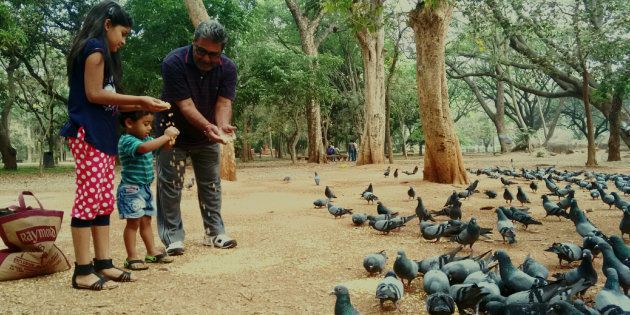
In the Kolkata of the 80s I was growing up, our decades-old family home had wooden beam ceiling, which was a breeding ground for house sparrows. Every morning, I'd wake up to their neurotic chirping and flying in and out of the nests, built with twigs and wires, and balanced precariously on the beams. Occasionally, a tiny egg would fall off the perch, leaving a sad trail of yolk and shell. Sometimes the eggs would hatch, revealing infants with their pink beaks, squealing hungrily.
I don't remember precisely when I stopped noticing the sparrows, before or after they started disappearing from our lives, but my experience, I can safely wager, is common to many. As we grow bigger and busier, creatures that were once close to us, often directly in our line of vision, begin to retreat. As children, we may have spent hours gazing at earthworms or at a line of ants marching along with grains of sugar on their backs, but our adult eyes are prone to glazing over these little creatures.
To look at the world from a young child's eye is to take note of ripples and currents that adults tend to miss out on. Children are in the unique position to observe the ground realities more closely, literally so, thanks to their height. But what opportunities does an urban, middle-class child, growing up in a "concrete jungle", surrounded by a dozen distracting gadgets, have to learn about nature or the environment?
I started reading Bijal Vachharajani's new book, So You Want To Know About The Environment, with these thoughts in my mind. By the time I finished it, I was more than delighted to stand corrected: if you wish to teach children, or learn yourselves, about the environment, you could do both even while you are trapped in high-rise fortresses or entangled in various electronic devices.

The trick, as the book seems to drive home with its entertaining jokes and endearing illustrations, is in the ability to cultivate a certain mindfulness among young people — and in ourselves as well. The word may have become overused and turned into a cliche, but at its truest, it inspires a keener self-awareness, which has little to do with either meditation or any such spiritual mumbo-jumbo.
Divided into five sections, the book imparts key lessons about the environment and its evolution. From climate change to sustainable farming to waste management, the topics are vast in scope but brought to life with examples closer home — and also with liberal doses of allusions and in-jokes that only the most ardent Harry Potter fans will get (we approve!). The text is spliced with illustrations as well as activity pages, asking readers to write down their own thoughts, run experiments on their own or provide counter-arguments. Adults are well advised to keep a pencil handy too.
Here are 5 quirky takeaways from the book.
Climate Change
For all those who say it's not happening, beginning with the man who has the world's most important job, does the phrase "smog meringues" ring a bell? No? If anyone's looking to run a DIY experiment, the details are on page 19 of the book. With unpredictable rain, droughts, crop failure and gloominess all around, you can't seriously stay like the proverbial ostrich, with your head under the ground, even as noxious gases fill the air and the temperature of the earth becomes unsteady.
Food
Every time you are about to consumed packaged food, give yourself a pause and read the fine print. Did you know, for instance, that the common additive put in your your bread to make it look whiter is also an ingredient in yoga mats?
Waste
If you thought there were 3 Rs of waste management, you missed out on one more. Reuse, Recycle and Reduce are not enough. The process must begin with the most important R of all — Refuse!
Water
The next time you groggily let the tap run for minutes on end while brushing your teeth in the morning, tell yourself the following (better still, stick these up above your bathroom mirror): to grow 1 kg of apples, we need 822 litres of water, to reap 1 kg of rice we need 2,497 litres of water, and to make 1 kg of chocolate we need — wait for it — 17,196 litres of water!
Wildlife
Here's an unusual example involving trees — they are very much part of the wildlife world, in case you're wondering. So you thought trees don't — rather, can't — move, did you? Karthikeyan S, chief naturalist at Jungle Lodges and Resorts, has news for you. While walking down Cubbon Park in Bengaluru one day, he'd picked up a core of a mahogany seed and thrown it in the air. The brown core, with seeds neatly arranged around it, "whirled like the blades of a helicopter" and dispersed the seeds.
Still want to insist trees don't move?
Also on HuffPost
